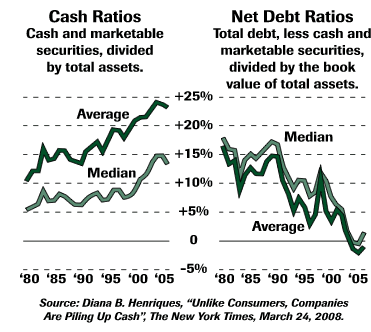2008 Q1 | “The Sun’ll Come Out Tomorrow…” – Annie
 About the best that can be said for the first quarter of 2008 is that it is over. The economy weakened in the quarter as continued worsening conditions in the housing market spread to the broader consumer sector. By quarter’s end, there were new signs of troubles in the capital spending sector of the economy. All of the developments were further burdened by extremely high oil prices, which briefly exceeded $110 a barrel in the quarter. The stubborn and surprising unity of the OPEC oil cartel is now having a negative impact on the developed, developing and, especially, the third world countries.
About the best that can be said for the first quarter of 2008 is that it is over. The economy weakened in the quarter as continued worsening conditions in the housing market spread to the broader consumer sector. By quarter’s end, there were new signs of troubles in the capital spending sector of the economy. All of the developments were further burdened by extremely high oil prices, which briefly exceeded $110 a barrel in the quarter. The stubborn and surprising unity of the OPEC oil cartel is now having a negative impact on the developed, developing and, especially, the third world countries.
Economic jitters spread through the financial markets in the first quarter, fueled by concerns that some of the newer synthetic financial securities, engineered by Wall Street, were coming unhinged. The loss of confidence reflected in the absence of liquidity in many of these exotic securities caused dislocations in the markets. Although most of the securities were held by large financial institutions all over the world, many were held by “sophisticated” hedge funds and other investment novelty organizations. Indeed, some notable hedge funds failed because of it, including one run by the once well-regarded Carlyle Group.
This liquidity crisis created a frenzy in several key markets, which placed enormous pressure on some of the major investment organizations. The Federal Reserve and the US Treasury provided emergency measures to shore up confidence and liquidity of the major interest sensitive markets. The Federal Reserve cut the Federal Funds Rate from 4.25% on December 31st, 2007 to 2.25% during the quarter. In addition, the Central Bank opened the discount window to both commercial banks and, for the first time since the depression, to investment banks as well. For the moment, this unusual response has stabilized the markets.
This effort brings two prior events to mind: the bailout of Long Term Capital Management in 1998 following a bad gamble on the direction of future interest rates and the rescue of the Hunt Brothers in 1980 after a failed attempt to corner the silver market. Both of these events posed similar threats to the stability of US financial markets. In both cases, disaster was avoided and order was quickly restored as the Federal Reserve provided a steady hand and adequate liquidity to bridge the problems.

We believe the current stress will also be favorably resolved for several reasons. First, unemployment levels are low in the United States at 4.8%, and recent large gains in employment in developing countries- particularly Brazil, Russia, India and China (BRIC countries) – should sustain growth for the present. This in turn should provide liquidity, and ultimately, confidence to the investment public. Second, even a modest slowing in economic growth can cool the sharp run-up in raw material prices, easing inflationary pressures. This would obviously be positive for financial instruments. Third, as world economics become more interconnected, central bankers have the ability to coordinate policies to stabilize the excesses that are affecting our market at the present time. Finally, housing in the United States is showing signs of stability, albeit at lower price points. Only the low- and mid-priced segments of the housing markets seem to be enjoying some improvement. Of course, several markets, notably in Florida and California, remain seriously overbuilt and recovery is not likely soon. But overall, the worst comparisons of new housing starts and sales of existing housing may be close to a bottom (see chart of New Housing Starts above).
– – – – – – – – – – – – – – – – – – – – – – – – – – – – – – – – – – – – – – – – – –
…the worst comparisons of new housing starts and sales of existing housing may be close to a bottom.
– – – – – – – – – – – – – – – – – – – – – – – – – – – – – – – – – – – – – – – – – –
This is not the first time the markets have dealt with real estate issues. In 1990-92 commercial real estate was seriously overbuilt throughout the United States and a government rescue was affected through the creation of the Resolution Trust Company (RTC), which bought up large quantities of defaulted commercial real estate, recapitalized the properties and successfully returned them to the market. The cost of that effort was around $200 billion dollars, which approximated 3.2% of the annual gross domestic product of the economy at that time, equalling $6.4 trillion. The current challenges in residential real estate have projected loses in a wide range of $200-$500 billion, which, at its worst, would constitute slightly under 3% of this year’s projected gross domestic product of $14.2 trillion. Therefore, on a relative basis, the present situation is comparable to the RTC bailout almost twenty years ago. We would note that the final bill for the RTC was well short of initial projections and this may also be true with respect to the current worst-case scenarios.
As one would expect, unfavorable economic developments were reflected in poor performance by the financial markets in the first quarter of 2008. Equities, as measured by the S&P 500 and Dow, fell during the quarter. The Dow and S&P lost 6.8% and 9.5%, respectively. The Nasdaq, by far the worst performer, was off 14.1%. These results are the worst since the third quarter of 2002, which many believe marked the end of that bear market. None of the eleven major economic sectors within the S&P 500 posted gains for the quarter. This very rare occurrence has often been associated with the end of a market correction. Fixed income markets also performed poorly, especially given the interest rate cuts implemented by the Federal Reserve. Longer-term rates have not responded to the rate cuts, as they have remained steady for over a year.
The most significant event in the quarter was the near collapse of Bear Stearns, a major investment banking firm and one of only twelve recognized government bond dealers. Over the weekend of March 15, the Treasury, the Federal Reserve, and several major Wall Street firms cobbled together a buyout, essentially forcing Bear Stearns to merge with the financial powerhouse of J.P. Morgan. In the short-term, emergency steps worked to stabilize investor fears, and at least for the present, no other firms have indicated they are facing crisis conditions.
Nevertheless, rumors abound. The Bear Stearns problem arose from reckless lending practices on the part of sub-prime lenders serving the lower end of the mortgage market. By permitting banks and brokerage firms to access the discount window (ultimately providing credit by the Federal Reserve to these institutions) the immediate crisis was averted. However, by flooding the market with liquidity, government has set the stage for high inflationary levels if these temporary measures are not reversed later this year. Essentially, it will be the challenge of the Federal Reserve to withdraw liquidity that was provided on an emergency basis to tide us over the immediate problems of Bear Sterns and potentially other banking institutions.

Then there are the super-bears. They argue the credit crisis in the mortgage area is bound to spread to credit card and auto finance paper. Given the delicate balance in the current underlying economic fundamentals, we think these concerns are overblown, but the situation requires close monitoring. The naysayers also cite high oil prices and high US trade deficits that have weakened the dollar, making it more expensive for Americans to purchase imported goods, resulting in higher levels of inflation. Also, demand for our exports is rising sharply contributing further to the inflationary pressures in the domestic economy. We are of the opinion that slowing domestic demand for consumer goods and capital equipment will moderate these concerns permitting a soft landing, or at worst, a short recession.
– – – – – – – – – – – – – – – – – – – – – – – – – – – – – – – – – – – – – – – – – –
…by flooding the market with liquidity, government has set the stage for high inflationary levels if these temporary measures are not reversed later this year.
– – – – – – – – – – – – – – – – – – – – – – – – – – – – – – – – – – – – – – – – – –
Why are we optimistic about the future movement in the prices for US equities?
We think there are several reasons to be optimistic. First, the US savings rate is finally showing signs of improvement. We read this as consumers paying off some debt, thereby making possible a consumer recovery. Second, US corporations are awash with liquidity. Cash as a percent of total assets on American corporate balance sheets are at the highest levels in over twenty-five years. This has enabled corporate share buybacks, currently at record levels, to support share prices (see chart above). Third, productivity gains, primarily as a result of greater investment in technology, continue at an above average pace. Fourth, growth rate of the BRIC countries continues, though at a somewhat slower rate. Growth is forecast in these countries, after inflation, to be 8-9% for 2008. Fifth, equity earnings projections have been scaled back slightly, but the current forecast still suggests that market valuations are in the area of 13-14x projected 2008 earnings, which has historically been an attractive entry point. Finally, the hedge funds, which fueled excess speculation in recent years, have been the focus of investor anger in recent weeks as manifested by record levels of withdrawal demands that have descended on these firms. The taming of the influence of hedge funds should be good for investors and bad for speculators, and could result in lower volatility in the equity markets in the weeks ahead. Although discouraged by the first quarter results in equities, we continue to believe that our forecast of equities, as measured by the Dow Jones Industrials, will finish the year between 14,500 and 15,000. This would reflect a 15-20% improvement from the current level of prices.
Turning to the fixed income outlook, we believe that interest rates could be pushed modestly lower in the next several months depending on the Feds reading of the recessionary forces in our economy. However, given the current low level of interest rates, the impact of any Federal Reserve activity in lowering rates would seem to be less likely to have a stimulative affect on the economy. As mentioned earlier, the need to remove liquidity that has been injected into our financial markets will cause interest rates to advance earlier in the recovery cycle than normally would have been expected. Therefore, our conclusion is that for the present, bond maturities should be kept relatively short in anticipation of higher rates later in 2008 and into 2009.
Finally, we would point out that the fourth year of a presidential term has generally been good for equities, and indeed the second half has been historically when the greatest returns have been realized. So, we conclude with the wonderful lyrics of the theme song from the play Annie which says, “Come what may, Tomorrow, Bet your bottom dollar, That tomorrow there’ll be sun.” The future returns in the financial markets should bring a brighter tomorrow. With this in mind, we are attempting to take advantage of the opportunities that are presently available.
—Jim Hardesty



